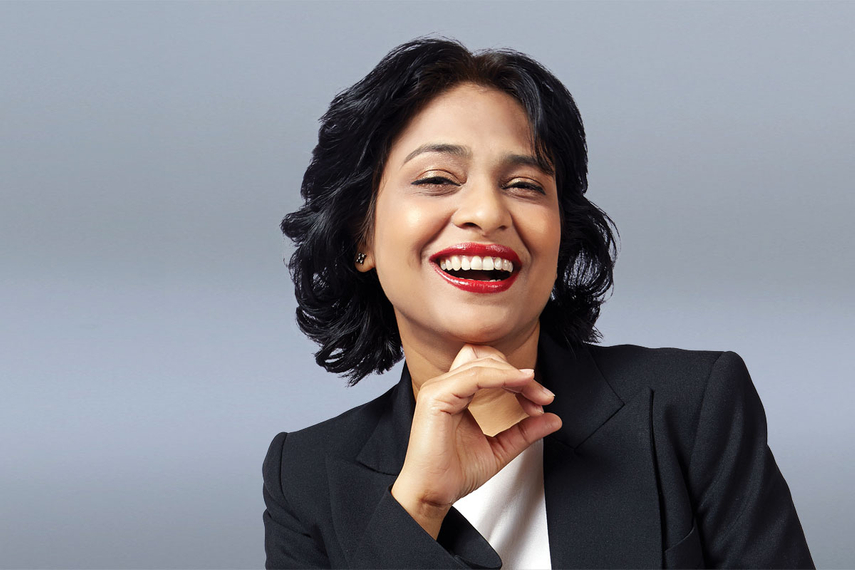Our lives are increasingly moving into the virtual world. L’Oréal is also noticing this: the world’s largest cosmetics company is working intensively to expand its own work with the latest technology. At the forefront of this change: digital and marketing director Asmita Dubey. In an interview with Forbes, the manager talks about virtual beauty, digital makeup in video calls and virtual hairstyles for avatars.
Vivatech in Paris is considered one of the largest technology conferences in Europe — if not the largest. Over four days, more than 150,000 visitors come to the exhibition hall in Paris to listen to speakers such as Tesla founder Elon Musk, Salesforce boss Marc Benioff and French President Emmanuel Macron.And the same applies to corporates: bulk instead of spill.
Companies like LVMH and Microsoft are building entire worlds on site to convince guests that they are at the forefront when it comes to technology. And local hero L’Oréal, the world’s largest cosmetics company with sales of €38 billion and more than 87,400 employees, is also prominently represented at Vivatech. The entire C-suite of the company is also on site to report on the technological innovations and developments.And there are actually a lot of them — so many that you almost lose track. L’Oréal works with virtual and augmented reality (VR or AR), with artificial intelligence (AI) and machine learning, and is interested in the blockchain and the metaverse. “We are moving from physical to digital to virtual beauty.
And that includes technologies like AR, VR, AI and spatial computing,” says Asmita Dubey, Chief Digital & Marketing Officer at L’Oréal, in an interview with Forbes.A concrete example of this change: Together with Microsoft, L’Oréal has developed a feature for the Teams software program that allows users to apply virtual makeup during video calls. “We work closely with Big Tech,” says Dubey. But there is also another reason, as Dubey emphasizes: “This is also because these are strong advertising ecosystems – and we are a big advertiser.” In fact, L’Oréal’s undeniably high level of popularity is costing it a lot: 12 billion The company spent € . on advertising in 2022; L’Oréal is considered the third largest advertiser in the world. It should be noted that the French company promotes a total of 36 brands, including Maybelline and Garnier.
“We are moving from physical to digital to virtual beauty. And that includes technologies like AR, VR, AI and spatial computing».
Anyone who spends so much money on advertising has to keep a close eye on the market. There are also major changes there, says Dubey, because customer behavior is changing. These are increasingly following creators, who are becoming increasingly important as advertising media for L’Oréal. Dubey gives an example from an area that at first glance wouldn’t necessarily be associated with a cosmetics company: gaming. “We are currently seeing creators building their own communities and ecosystems around themselves. You can also see this in gaming: There are 3.2 billion gamers worldwide and more than 40% of them are women. They watch games on Twitch, play Fortnite, or even create their own games on Roblox.
”In general, young people in particular are increasingly interested in beautifying not only their physical self, but also their virtual self. Dubey: “For ‘Ready Player Me’ we created virtual hairstyles with L’Oréal Professional and virtual make-up looks with Maybelline for avatars. Young people, especially Generation Z, feel very comfortable with their digital twins.”As progressive as that sounds, it’s also clear that L’Oréal makes its money from products in the physical world — and not from virtual makeup. But can that still happen? Could L’Oréal also make relevant sales with lipstick for avatars — or should the digital world «just» serve as an accelerator for the physical one? Dubey remains vague: “We have always said that we will move from 2D to 3D beauty. This is exactly the change that is happening now. VR and AR are great tools to control this.
At L’Oréal, we immediately embrace new trends, evaluate our biggest successes, and then we scale.”Dubey was born in India and studied Statistics and Marketing Economics & Management. She started her career at the advertising agency Dentsu before moving to the McCann agency and then to Mindshare in Shanghai. There she became Managing Director of Team L’Oréal before switching sides in 2013 to become Chief Marketing Officer of L’Oréal China. From 2017 she worked at the headquarters in Paris, and since 2021 as Chief Digital & Marketing Officer.The fact that Dubey knows both India and China well is certainly beneficial: both are considered growth markets for the cosmetics industry.
And Dubey has learned first-hand that the group needs to differentiate regionally: “With the increase in creators, new business models are also emerging. For example, social commerce is booming in Latin America and Southeast Asia, such as in Indonesia, where we are increasingly relying on livestream commerce.
”But in the conversation, Dubey always comes up with the same topics: focus on the customer, open-mindedness when it comes to new technologies and cooperation with external partners. And: Despite all the focus on technological innovations, L’Oréal does not want to lose sight of the actual goal, as Dubey says: “We are convinced that we offer everyone unique, holistic and integrated beauty experiences in their infinite diversity and their individual requirements can.»

